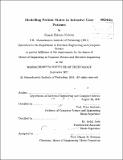Modelling patient states in intensive care patients
Author(s)
Kshetri, Kanak Bikram
DownloadFull printable version (3.990Mb)
Alternative title
Modeling evolution of patient state in ICU and response to medical interventions
Other Contributors
Massachusetts Institute of Technology. Dept. of Electrical Engineering and Computer Science.
Advisor
Peter Szolovits and Rohit Joshi.
Terms of use
Metadata
Show full item recordAbstract
Extensive bedside monitoring in hospital Intensive Care Units (ICU) has resulted in a deluge of information on patient physiology. Consequently, clinical decision makers have to reason with data that is simultaneously large and high-dimensional. Mechanisms to compress these datasets while retaining their salient features are in great need. Previous work in this area has focused exclusively on supervised models to predict specific hazardous outcomes like mortality. These models, while effective, are highly specific and do not generalize easily to other outcomes. This research describes the use of non-parametric unsupervised learning to discover abstract patient states that summarize a patient's physiology. The resulting model focuses on grouping physiologically similar patients instead of predicting particular outcomes. This type of cluster analysis has traditionally been done in small, low-dimensional, error-free datasets. Since our real-world clinical dataset affords none of these luxuries, we describe the engineering required to perform the analysis on a large, high-dimensional, sparse, noisy and mixed dataset. The discovered groups showed cohesiveness, isolation and correspondence to natural groupings. These groups were also tested for enrichment towards survival, Glasgow Coma Scale values and critical heart rate events. In each case, we found groups which were enriched and depleted towards those outcomes.
Description
Thesis (M. Eng.)--Massachusetts Institute of Technology, Dept. of Electrical Engineering and Computer Science, 2011. Cataloged from PDF version of thesis. Includes bibliographical references (p. 71-74).
Date issued
2011Department
Massachusetts Institute of Technology. Department of Electrical Engineering and Computer SciencePublisher
Massachusetts Institute of Technology
Keywords
Electrical Engineering and Computer Science.